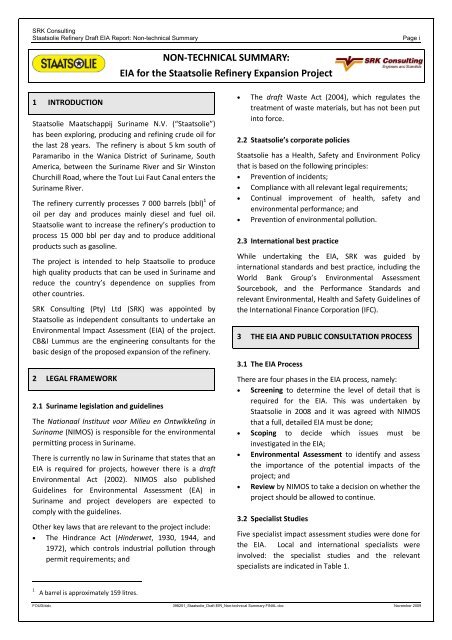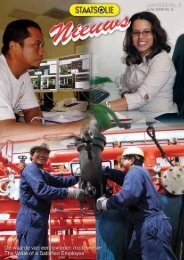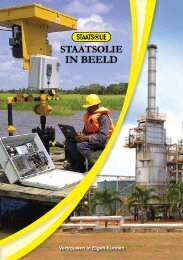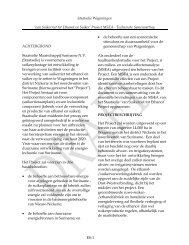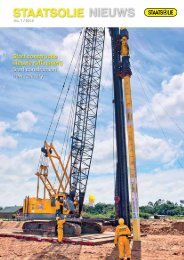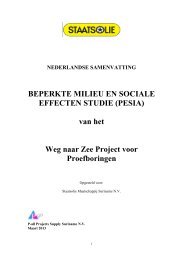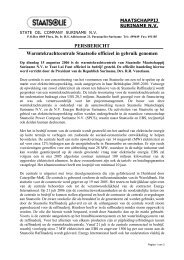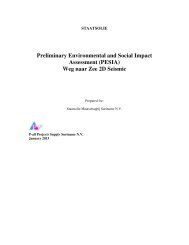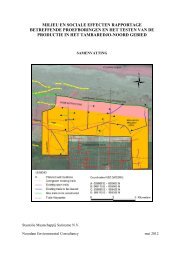English - Staatsolie
English - Staatsolie
English - Staatsolie
Create successful ePaper yourself
Turn your PDF publications into a flip-book with our unique Google optimized e-Paper software.
SRK Consulting<br />
<strong>Staatsolie</strong> Refinery Draft EIA Report: Non-technical Summary Page i<br />
1 INTRODUCTION<br />
NON-TECHNICAL SUMMARY:<br />
EIA for the <strong>Staatsolie</strong> Refinery Expansion Project<br />
<strong>Staatsolie</strong> Maatschappij Suriname N.V. (“<strong>Staatsolie</strong>”)<br />
has been exploring, producing and refining crude oil for<br />
the last 28 years. The refinery is about 5 km south of<br />
Paramaribo in the Wanica District of Suriname, South<br />
America, between the Suriname River and Sir Winston<br />
Churchill Road, where the Tout Lui Faut Canal enters the<br />
Suriname River.<br />
The refinery currently processes 7 000 barrels (bbl) 1 of<br />
oil per day and produces mainly diesel and fuel oil.<br />
<strong>Staatsolie</strong> want to increase the refinery’s production to<br />
process 15 000 bbl per day and to produce additional<br />
products such as gasoline.<br />
The project is intended to help <strong>Staatsolie</strong> to produce<br />
high quality products that can be used in Suriname and<br />
reduce the country’s dependence on supplies from<br />
other countries.<br />
SRK Consulting (Pty) Ltd (SRK) was appointed by<br />
<strong>Staatsolie</strong> as independent consultants to undertake an<br />
Environmental Impact Assessment (EIA) of the project.<br />
CB&I Lummus are the engineering consultants for the<br />
basic design of the proposed expansion of the refinery.<br />
2 LEGAL FRAMEWORK<br />
2.1 Suriname legislation and guidelines<br />
The Nationaal Instituut voor Milieu en Ontwikkeling in<br />
Suriname (NIMOS) is responsible for the environmental<br />
permitting process in Suriname.<br />
There is currently no law in Suriname that states that an<br />
EIA is required for projects, however there is a draft<br />
Environmental Act (2002). NIMOS also published<br />
Guidelines for Environmental Assessment (EA) in<br />
Suriname and project developers are expected to<br />
comply with the guidelines.<br />
Other key laws that are relevant to the project include:<br />
• The Hindrance Act (Hinderwet, 1930, 1944, and<br />
1972), which controls industrial pollution through<br />
permit requirements; and<br />
1 A barrel is approximately 159 litres.<br />
• The draft Waste Act (2004), which regulates the<br />
treatment of waste materials, but has not been put<br />
into force.<br />
2.2 <strong>Staatsolie</strong>’s corporate policies<br />
<strong>Staatsolie</strong> has a Health, Safety and Environment Policy<br />
that is based on the following principles:<br />
• Prevention of incidents;<br />
• Compliance with all relevant legal requirements;<br />
• Continual improvement of health, safety and<br />
environmental performance; and<br />
• Prevention of environmental pollution.<br />
2.3 International best practice<br />
While undertaking the EIA, SRK was guided by<br />
international standards and best practice, including the<br />
World Bank Group’s Environmental Assessment<br />
Sourcebook, and the Performance Standards and<br />
relevant Environmental, Health and Safety Guidelines of<br />
the International Finance Corporation (IFC).<br />
3 THE EIA AND PUBLIC CONSULTATION PROCESS<br />
3.1 The EIA Process<br />
There are four phases in the EIA process, namely:<br />
• Screening to determine the level of detail that is<br />
required for the EIA. This was undertaken by<br />
<strong>Staatsolie</strong> in 2008 and it was agreed with NIMOS<br />
that a full, detailed EIA must be done;<br />
• Scoping to decide which issues must be<br />
investigated in the EIA;<br />
• Environmental Assessment to identify and assess<br />
the importance of the potential impacts of the<br />
project; and<br />
• Review by NIMOS to take a decision on whether the<br />
project should be allowed to continue.<br />
3.2 Specialist Studies<br />
Five specialist impact assessment studies were done for<br />
the EIA. Local and international specialists were<br />
involved: the specialist studies and the relevant<br />
specialists are indicated in Table 1.<br />
FOUD/dalc 398251_<strong>Staatsolie</strong>_Draft EIR_Non-technical Summary FINAL.doc November 2009
SRK Consulting<br />
<strong>Staatsolie</strong> Refinery Draft EIA Report: Non-technical Summary Page ii<br />
Table 1: EIA specialist studies and specialists.<br />
Specialist<br />
study / report<br />
Geology, Soils<br />
and Ecology<br />
Surface and<br />
Groundwater<br />
Specialist teams<br />
Dirk Noordam and Pieter Teunissen,<br />
independent consultants from Suriname<br />
Tony Rex, SRK United Kingdom<br />
Air Quality Victor von Reiche and Lucian Burger<br />
Airshed Planning Professionals, South Africa<br />
Noise Bora Arpacioglu, SRK Turkey<br />
Social Sue Reuther, SRK South Africa<br />
3.3 Public Consultation<br />
Public consultation is an important part of the EIA that<br />
runs throughout the process. During the Screening<br />
Phase of the EIA, <strong>Staatsolie</strong> advertised the proposed<br />
project and held meetings with the local communities.<br />
During the Scoping Phase, SRK compiled an initial list of<br />
stakeholders, advertised the project and released a<br />
Background Information Document. Meetings were<br />
also held with authorities to discuss the Study Plan<br />
compiled by SRK.<br />
The Draft EIA Report has been made available for public<br />
comment and this Non-technical Summary in both<br />
<strong>English</strong> and Dutch has been sent to all stakeholders on<br />
the list. Public consultation meetings will be held to<br />
SPCS<br />
site<br />
Existing<br />
refinery<br />
site<br />
discuss the EIA Report and all stakeholders are invited<br />
to comment on the Draft EIA Report (see the end of this<br />
document for information on how to take part).<br />
3.4 Interaction with the Design Team<br />
There have been ongoing discussions between the EIA<br />
team and <strong>Staatsolie</strong>’s design and engineering team<br />
throughout the EIA process. It was therefore possible to<br />
limit the potential impacts of the project by changing<br />
the design of the expanded refinery.<br />
4 SITE AND PROJECT DESCRIPTION<br />
4.1 The Refinery Site<br />
The <strong>Staatsolie</strong> refinery is in a semi-urban area and is<br />
about 27 ha in size (excluding the 9 ha expansion area<br />
next to it) (see Figure 1). Houses in Dijkveld are on the<br />
other side of the Tout Lui Faut Canal. There are<br />
industrial businesses on both sides of the refinery along<br />
the Suriname River and undeveloped land to the south<br />
and southwest.<br />
Crude oil is pumped to the refinery via pipeline and<br />
products are taken away by ship using a jetty on the<br />
Suriname River and by truck (road).<br />
Proposed<br />
expansion<br />
Figure 1: Google Earth image showing the existing <strong>Staatsolie</strong> refinery site and proposed expansion area.<br />
FOUD/dalc 398251_<strong>Staatsolie</strong>_Draft EIR_Non-technical Summary FINAL.doc November 2009<br />
area
SRK Consulting<br />
<strong>Staatsolie</strong> Refinery Draft EIA Report: Non-technical Summary Page iii<br />
At the existing refinery, crude oil is stored in special<br />
tanks on the site. The crude oil is then distilled into<br />
diesel, heavy vacuum gasoil and vacuum residue. The<br />
vacuum residue is turned into asphalt bitumen and the<br />
remaining product is blended with the heavy vacuum<br />
gasoil to produce fuel oil. The refinery consists of two<br />
main processing units, storage facilities and utilities.<br />
The refinery products are exported by pipeline, truck<br />
and ships from the jetty.<br />
4.2 The Proposed Expanded Refinery<br />
New processing units, utilities and storage facilities will<br />
be built to expand the existing refinery; mostly on the 9<br />
Existing Site<br />
ha expansion area, but also on the existing refinery site<br />
(see Figure 1 and Figure 2).<br />
The expanded refinery will involve a more complex<br />
crude oil refining process and will need several new<br />
processing units to:<br />
• Separate the crude oil into intermediate products<br />
(e.g. through distillation);<br />
• Convert heavy intermediate products into lighter<br />
products (e.g. through hydrocracking and<br />
visbreaking); and<br />
• Upgrade intermediate products to meet the<br />
required end product specifications (e.g. through<br />
catalytic reforming).<br />
Proposed Expansion Area<br />
Figure 2: Existing and proposed refinery layout. Green shading indicates new units.<br />
FOUD/dalc 398251_<strong>Staatsolie</strong>_Draft EIR_Non-technical Summary FINAL.doc November 2009
SRK Consulting<br />
<strong>Staatsolie</strong> Refinery Draft EIA Report: Non-technical Summary Page iv<br />
The expanded refinery will also require new wastewater<br />
treatment facilities, a new (higher) flare, expanded<br />
storage facilities for crude oil and products, and<br />
additional utilities. The proposed layout of the<br />
expanded refinery is shown in Figure 2.<br />
The new expanded refinery will produce premium<br />
diesel, gasoline (RON 95) fuel oil, asphalt bitumen and<br />
sulphuric acid, which will be exported from the refinery<br />
by ship (from the existing jetty), truck and pipeline.<br />
<strong>Staatsolie</strong> has committed to strict standards for air<br />
emissions, noise and wastewater quality for the<br />
proposed expanded refinery. These standards are<br />
based on international guidelines and standards such as<br />
those of the European Community, World Health<br />
Organisation, World Bank/IFC and the Netherlands.<br />
A 14 megawatt (MW) power plant (with two 7 MW<br />
engines) managed by the <strong>Staatsolie</strong> Power Company<br />
Suriname (SPCS) is located on the north-western part of<br />
the refinery site. The power plant became fully<br />
operational in August/September 2009; before that it<br />
was only run every now and then. The plant provides<br />
power to the national grid.<br />
5 DESCRIPTION OF THE AFFECTED ENVIRONMENT<br />
5.1 Biophysical Environment<br />
Suriname has a typical tropical climate with high rainfall<br />
and high temperatures. Most rain falls during the long<br />
and short rainy seasons, which are separated by long<br />
and short dry seasons.<br />
In the area around the refinery site, daytime winds<br />
usually blow from the east and night-time winds from<br />
the north-east. Conditions are calmer at night than<br />
during the day. The existing refinery emits several<br />
different types of pollutants into the air, including<br />
hydrogen sulphide (H2S), which is responsible for the<br />
smell that can sometimes be smelled around the<br />
refinery. However, the air quality specialist study found<br />
that the levels of all of these pollutants are well below<br />
the relevant international health standards and<br />
therefore do not pose any health risk for the<br />
surrounding communities. The study further showed<br />
that the SPCS power plant emits very similar pollutants<br />
(but not H2S) to the refinery and actually emits more of<br />
some of these pollutants than the refinery does.<br />
The refinery is located on poorly drained clay soils<br />
deposited by the Suriname River. These soils are not<br />
really suitably for agricultural crops or livestock. A soil<br />
investigation in early 2009 found evidence of oil<br />
pollution on the proposed expansion area, which<br />
resulted from a spill at the refinery several years ago.<br />
Noise levels in the areas surrounding the refinery site<br />
are below the IFC’s guidelines levels for residential,<br />
commercial and industrial areas, although, , since the<br />
power plant started working continuously in<br />
August/September 2009, night-time noise levels in the<br />
Dijkveld residential area are close to the relevant<br />
guideline level.<br />
The refinery is located on the lower stretches of the<br />
Suriname River (see Figure 3), which flows in a generally<br />
north-south direction.<br />
Figure 3: The refinery site as seen from the Suriname<br />
River. (Photo by T. Rex.)<br />
The Tout Lui Faut Canal releases effluent (wastewater)<br />
and stormwater (rain water) into the Suriname River<br />
just downstream of the refinery site. Groundwater is<br />
abstracted from an existing borehole on the refinery<br />
site from a deep-lying aquifer. There is also very<br />
shallow groundwater on the refinery site, but this is not<br />
used.<br />
Very little natural vegetation and/or habitat remains in<br />
the vicinity of the refinery and secondary growth of low<br />
marsh forest occurs in small patches. Until recently, the<br />
proposed expansion area was covered with such<br />
secofndary forest, but this was cleared recently. There<br />
are no plant species that are important for conservation<br />
in the study area.<br />
Terrestrial (land-based) animals that may occur along<br />
the lower Suriname River are those that commonly live<br />
close to humans, such as opossums, bats, monkeys,<br />
sloths, rodents, snakes, lizards and birds. No species of<br />
concern are expected to occur in the area.<br />
FOUD/dalc 398251_<strong>Staatsolie</strong>_Draft EIR_Non-technical Summary FINAL.doc November 2009
SRK Consulting<br />
<strong>Staatsolie</strong> Refinery Draft EIA Report: Non-technical Summary Page v<br />
No fish species of concern are known to occur in this<br />
stretch of the Suriname River. The Suriname river<br />
dolphin occurs as far upstream as Paranam and the<br />
vulnerable West Indian Manatee may also occur in the<br />
Suriname River. The endangered Giant river otter is<br />
known to occur in Suriname but is not expected to live<br />
in the study area (although they may visit the area).<br />
The vulnerable Yellow-spotted sideneck turtle may also<br />
occur in the study area.<br />
5.2 Socio-economic Environment<br />
The <strong>Staatsolie</strong> refinery site is located in the Ressort<br />
Houttuin in the district of Wanica. The local<br />
communities near the refinery are Dijkveld and Tout Lui<br />
Faut. Part of Dijkveld falls within Ressort Livorno in the<br />
Para District.<br />
Ressort Houttuin is home to about 13 000 people, with<br />
more people living in Dijkveld than other parts of the<br />
ressort.<br />
Historically, Ressort Houttuin was a rural farming area<br />
where vegetables, fruits and livestock were farmed.<br />
Local commercial activity is increasing, especially near<br />
the refinery site where there are several existing and<br />
planned commercial and light industrial developments<br />
(see Figure 4). Most people from the Dijkveld area grow<br />
LEGEND:<br />
Commercial area<br />
Secondary marsh forest<br />
River side vegetation<br />
Abandoned / fallow land<br />
and scattered small-scale<br />
agriculture and grazing<br />
Residential areas<br />
Agriculture<br />
Industry, workshops and<br />
warehouses<br />
Sand mining<br />
vegetables and fruit and keep livestock in their yards.<br />
There is also a commercial farm near to the refinery<br />
where fruit (mostly West Indian cherry) is grown.<br />
About 16 – 20 local commercial fishermen (with 12<br />
small boats) fish in the Suriname River and have their<br />
base near the sluice gate on the Tout Lui Faut Canal.<br />
The government employs about half of the local<br />
(employed) population and many local people travel to<br />
Paramaribo for work every day. About 50 people<br />
residing in Ressort Houttuin and Dijkveld are employed<br />
by the <strong>Staatsolie</strong> refinery (about 30% of refinery<br />
workers). Approximately 115 people living in the<br />
District Wanica are employed at the company’s<br />
Saramacca Operations.<br />
There is one main policlinic and a smaller health post in<br />
Ressort Houttuin, both run by the Regionale<br />
Gezondheidsdienst (RGD). Ressort Houttuin has one<br />
junior secondary school and five primary schools, two of<br />
which are located in the Dijkveld area.<br />
Most households in Ressort Houttuin have electricity,<br />
telephones and water, but many also collect rainwater<br />
to reduce costs. Waste is collected from households in<br />
Houttuin and taken to the waste disposal site at<br />
Ornamibo in Ressort Domburg.<br />
Figure 4: Land use and vegetation in the vicinity of the refinery site. (Adapted from Noordam & Teunissen, 2009)<br />
FOUD/dalc 398251_<strong>Staatsolie</strong>_Draft EIR_Non-technical Summary FINAL.doc November 2009<br />
N
SRK Consulting<br />
<strong>Staatsolie</strong> Refinery Draft EIA Report: Non-technical Summary Page vi<br />
The two regionally important roads in the area, Martin<br />
Luther King Road and Sir Winston Churchill Road, are<br />
surfaced. Martin Luther King Road is in bad condition in<br />
the Houttuin area. Traffic levels on both roads are<br />
slowly increasing and are high during morning and<br />
evening rush hour. The important ressort-level roads<br />
running in a south-west/north-east direction are also<br />
surfaced, but most of the smaller roads in the area are<br />
not. Flooding is a problem on these roads in the rainy<br />
season.<br />
The Suriname River is used by all major cargo vessels<br />
travelling to the Port of Paramaribo and further<br />
upstream. There are many small quays and jetties,<br />
which are used by industries located on the riverbank<br />
(mostly on the western bank), as well as passenger and<br />
fishing boats.<br />
There is an increasing need for housing in Ressort<br />
Houttuin and several housing projects are planned or<br />
currently underway. As a result, Houttuin is slowly<br />
losing its farming character and is becoming more<br />
urban. Most new and planned housing and industrial<br />
developments in Ressort Houttuin are to the south of<br />
the <strong>Staatsolie</strong> refinery, along Sir Winston Churchill Road<br />
and Martin Luther King Road.<br />
6 IMPACT ASSESSMENT AND OVERVIEW OF<br />
MANAGEMENT PLANS<br />
A summary of the potential impacts and their<br />
significance and the key findings of the impact<br />
assessment are discussed below and summarised in<br />
Table 2.<br />
6.1 Biophysical Impact Assessment<br />
Key observations with regard to the potential<br />
biophysical impacts of the planned project activities are:<br />
• Potential contamination of soil resources, changes<br />
to the landscape and limitations imposed on land<br />
uses around the refinery site during the<br />
construction and operation phases are all assessed<br />
to be insignificant or of very low to low significance.<br />
A large, accidental release of pollutants (e.g. an oil<br />
spill) could result in soil contamination of medium<br />
significance, but would be of very low significance if<br />
mitigation measures are implemented.<br />
• The noise impact on surrounding communities<br />
during the construction phase (mainly because of<br />
construction vehicles and piling) is assessed be of<br />
very low significance.<br />
The refinery expansion project (and SPCS power<br />
plant) will result in a reduction in noise levels in the<br />
residential areas to the west of the refinery site,<br />
due to the fact that new refinery units will be<br />
placed on the southern side of the existing refinery<br />
(i.e. futher away from the residential area) and<br />
some existing refinery units will be moth-balled.<br />
Noise levels in the undeveloped and industrial areas<br />
to the south of the refinery site will increase<br />
slightly.<br />
However, the noise level changes will not be<br />
noticeable to the average person and the resultant<br />
noise levels will be below the international<br />
standards adopted for the project. The impact of<br />
noise on surrounding communities during the<br />
operation phase is therefore assessed to be<br />
insignificant.<br />
• Air pollutants emitted from the refinery (and SPCS<br />
power plant) include sulphur dioxide [SO2], carbon<br />
monoxide [CO], nitrogen oxides [NOX], particulates,<br />
carcinogenic compounds (i.e. benzene), volatile<br />
organic compounds (VOCs) and hydrogen sulphide<br />
(H2S).<br />
The emissions of most of these pollutants will<br />
increase with the refinery expansion project, but no<br />
exceedances of the adopted air concentration<br />
standards are predicted with the exception of H2S.<br />
H2S emissions (i.e. odours) will reduce, but they will<br />
still slightly exceed the odour threshold standard.<br />
The potential impact of a reduction in air quality<br />
and impaired human health is assessed to be of low<br />
significance, while the reduced odour emissions are<br />
considered to be a positive impact of low<br />
significance. Air quality in the vicinity of the<br />
refinery is not expected to adversely affect<br />
vegetation and crops and the impact is assessed to<br />
be of very low significance.<br />
• Impacts on surface water resources such as<br />
increased sedimentation and turbidity in the<br />
Suriname River (from construction activities) and<br />
contamination of the Suriname River by stormwater<br />
runoff (due to leaks and spills of contaminants on<br />
the refinery site) would be insignificant or of very<br />
low to low significance with mitigation.<br />
The impact of the discharge of treated wastewater<br />
from the expanded refinery to the Suriname River<br />
would have a low positive significance, due to<br />
FOUD/dalc 398251_<strong>Staatsolie</strong>_Draft EIR_Non-technical Summary FINAL.doc November 2009
SRK Consulting<br />
<strong>Staatsolie</strong> Refinery Draft EIA Report: Non-technical Summary Page vii<br />
improved wastewater treatment and strict effluent<br />
quality standards that <strong>Staatsolie</strong> will implement.<br />
• Only the shallow, localised groundwater on the<br />
refinery site may be affected by the proposed<br />
activities; the deeper, underlying aquifer from<br />
which water is abstracted will not be affected. The<br />
potential contamination of groundwater resources<br />
during the construction and operation phases is<br />
assessed to be insignificant with mitigation.<br />
• Very little natural vegetation/habitat or noteworthy<br />
terrestrial fauna occurs in the area. The potential<br />
impact on vegetation, terrestrial habitat and<br />
terrestrial fauna is assessed to be of very low<br />
significance with mitigation.<br />
• The potential impact on aquatic ecology in the<br />
Suriname River, through exposure to increased<br />
turbidity/sedimentation and pollutants, is assessed<br />
to be of very low significance with mitigation.<br />
6.2 Socio-economic and Transportation Impact<br />
Assessment<br />
• Positive socio-economic impacts of the proposed<br />
refinery expansion project include the generation of<br />
(limited) employment opportunities (especially<br />
during construction), which is assessed to be of low<br />
positive significance. The project’s contribution to<br />
the economy of Suriname (through investment as<br />
well as reducing the country’s dependence on<br />
imported fuels) is assessed to be of very high<br />
positive significance.<br />
Other potential socio-economic effects include<br />
impacts on the livelihoods, quality of life and social<br />
fabric of surrounding communities (through effects<br />
on agricultural activities and nuisance impacts and<br />
an influx of construction workers from outside the<br />
area). These impacts are assessed to be of very low<br />
significance with mitigation.<br />
• Transportation impacts of the expansion project<br />
include additional traffic on the local road network<br />
during construction as well as additional river traffic<br />
on the Suriname River during both construction and<br />
operations. The impact of this additional traffic on<br />
other road and river users is assessed to be of very<br />
low and low significance, respectively.<br />
6.3 Cumulative Effects<br />
The existing refinery and the SPCS power plant are the<br />
main activities that, with the refinery expansion project,<br />
will have cumulative effects on the environment.<br />
The existing power plant significantly affects air quality<br />
and noise levels in the area around the refinery site and<br />
the possible future expansion of the power plant may<br />
further reduce the quality of the environment.<br />
However, concentrations of pollutants emitted by the<br />
refinery and the expanded power plant will not exceed<br />
the relevant health standards.<br />
6.4 Overview of Management Plans<br />
SRK has compiled the following draft management plans<br />
for the proposed Refinery Expansion Project:<br />
• Environmental Management and Monitoring Plan<br />
(EMMP), which sets out the approach that will be<br />
followed during the construction and operations<br />
phases to manage possible negative impacts and<br />
improve possible benefits; and<br />
• Conceptual Closure Plan (CCP), which sets out the<br />
technical and financial responsibilities that<br />
<strong>Staatsolie</strong> will have when the refinery is closed.<br />
In addition, a Quantitative Risk Assessment (QRA) and a<br />
Framework Emergency Response Plan (ERP) will be<br />
compiled. The QRA looks at the possible risks to the<br />
local communities (society) that may exist because of<br />
the expanded refinery and evaluates these risks against<br />
international standards.<br />
7 CONCLUSIONS<br />
The EIA has identified and assessed the potential<br />
impacts of the proposed refinery expansion project.<br />
During the EIA the design team had the opportunity to<br />
incorporate environmental considerations into the<br />
design at an early stage, to avoid significant<br />
environmental impacts. SRK believes that through<br />
effective implementation of the recommended<br />
management measures, any remaining negative impacts<br />
can be further reduced to acceptable levels. <strong>Staatsolie</strong><br />
will need to make sure that the expanded refinery is<br />
operated to high standards to keep environmental<br />
impacts to a minimum. This will require commitment,<br />
persistence and ongoing monitoring of performance.<br />
FOUD/dalc 398251_<strong>Staatsolie</strong>_Draft EIR_Non-technical Summary FINAL.doc November 2009
SRK Consulting<br />
<strong>Staatsolie</strong> Refinery Draft EIA Report: Non-technical Summary Page viii<br />
8 WAY FORWARD<br />
The Draft EIA Report and the Draft EMMP are now<br />
available for people to read and comment on. All<br />
comments received will be used to finalise the reports<br />
before they are submitted to NIMOS to use in their<br />
decision-making.<br />
A public consultation meeting will be held to present<br />
and discuss the findings of the EIA with interested and<br />
affected parties. Details are as follows:<br />
SRK Consulting in South Africa:<br />
Contact person: Danélle Fourie<br />
Contact details:<br />
Postnet Suite #206, Private Bag X18,<br />
Rondebosch, 7701, South Africa<br />
Tel: + 27 21 659 3060<br />
Fax: +27 21 685 7105<br />
E-mail: dfourie@srk.co.za<br />
Venue: <strong>Staatsolie</strong> Refinery, Tout Lui Faut<br />
Date: Saturday 28 November 2009<br />
Time: 14h00 – 16h30<br />
Further details can be obtained from the contact<br />
persons.<br />
In order for comments to be included in the Final EIA<br />
Report and/or the Final EMMP, they must reach the<br />
contact person(s) no later than 14 December 2009.<br />
If you have any questions about the project or would like to comment on the reports, please contact:<br />
SRK Consulting in Suriname:<br />
Contact person: Henna Guicherit<br />
Contact details:<br />
Henck Arronstraat 116A,<br />
Paramaribo,<br />
Suriname<br />
Tel/Fax: + 597 520916<br />
E-mail: hguicherit@sr.net<br />
FOUD/dalc 398251_<strong>Staatsolie</strong>_Draft EIR_Non-technical Summary FINAL.doc November 2009
SRK Consulting<br />
<strong>Staatsolie</strong> Refinery Draft EIA Report: Non-technical Summary Page ix<br />
Table 2: Summary of potential impacts of the proposed refinery expansion project.<br />
Potential negative impacts are shaded in orange, benefits are shaded in green. White indicates a neutral impact.<br />
# Impact Significance rating Key mitigation/optimisation measures<br />
BIOPHYSICAL IMPACTS<br />
G1<br />
G2<br />
Potential contamination of soil resources<br />
as a result of small leaks and spills<br />
Potential contamination of soil resources<br />
as a result of a large, accidental release<br />
during the operations phase<br />
Altered landscape (visual quality and<br />
sense of place)<br />
Before mitigation/<br />
optimisation<br />
After mitigation/<br />
optimisation<br />
Low Insignificant<br />
Medium Very Low<br />
Low Low<br />
G3 Impact on land use Low Low<br />
Undertake regular maintenance of vehicles and machinery to identify and repair minor leaks.<br />
Develop (or maintain and adapt) procedures for the safe transport, handling and storage of potential<br />
pollutants.<br />
Use spill prevention measures such as drip trays during refuelling, bunds around storage tanks, etc. to<br />
capture spills and contain any leaks.<br />
Ensure all on site staff are trained in the use of spill prevention measures.<br />
Clean up any spills (including existing spills) immediately, through containment and removal of free<br />
product and appropriate rehabilitation or disposal of contaminated soils.<br />
Ensure adequate spill response measures are included in the Emergency Response Plan.<br />
Regularly inspect and maintain all equipment to prevent equipment failures.<br />
Ensure all on site staff are trained in the requirements of the Emergency Response Plan.<br />
Avoid overloading of storage tanks and vehicles during refuelling and ensure all drivers observe the rules<br />
of the road.<br />
Clean up any spills immediately, through containment and removal of free product and appropriate<br />
rehabilitation or disposal of contaminated soils.<br />
Establish or retain as much vegetation as possible around the perimeter of the expanded refinery to act<br />
as a visual screen between project activities and nearby visual receptors.<br />
Implement mitigation measures to reduce the potential air quality impacts.<br />
Establish or retain as much vegetation as possible around the perimeter of the expanded refinery to act<br />
as a visual screen between project activities and nearby visual receptors.<br />
Implement mitigation measures to reduce the potential noise and air quality impacts.<br />
FOUD/dalc 398251_<strong>Staatsolie</strong>_Draft EIR_Non-technical Summary FINAL.doc November 2009
SRK Consulting<br />
<strong>Staatsolie</strong> Refinery Draft EIA Report: Non-technical Summary Page x<br />
# Impact Significance rating Key mitigation/optimisation measures<br />
AQ1<br />
Reduction in air quality and impaired<br />
human health due to operations phase<br />
emissions<br />
Before mitigation/<br />
optimisation<br />
After mitigation/<br />
optimisation<br />
Medium Low<br />
AQ2 Reduced odour emissions Low Low n/a<br />
AQ3<br />
Impacts on vegetation caused by poor air<br />
quality<br />
Very Low n/a n/a<br />
N1 Noise during the construction phase Low Very Low<br />
N2 Noise during the operations phase Insignificant Insignificant<br />
WR1<br />
Potential increased turbidity and<br />
sedimentation in the Suriname River<br />
during the construction phase.<br />
Insignificant Insignificant<br />
Ensure that the boiler stack height is 15m+ (as assumed in emissions modeling).<br />
Use low sulphur fuels if monitoring identifies any stack or ambient concentration exceedances for SO2.<br />
Ensure that all significant sour gas streams are routed to the sulphur recovery unit as planned and do<br />
not combust in furnaces, boilers or flares.<br />
Install low NOX burners when burner sets are replaced in existing plant.<br />
Consider the installation of multi-cyclones, fabric filters or scrubbers to control soot emissions or<br />
alternative technologies requiring less soot blowing. Alternatively, restrict soot blowing to periods of<br />
good dispersion potential.<br />
Use liquefied petroleum gas (LPG) and refinery fuel gas (RFG) firing, and distillate oil for start-up. Fuel oil<br />
should only be fired if RFG supply is inadequate.<br />
Implement an initial air quality monitoring campaign to compare modelled predictions against<br />
measured data.<br />
Schedule noise-generating construction activities, in particular piling activities, during business hours to<br />
avoid after hours noise impacts.<br />
Ensure adequate maintenance of construction vehicles and machinery to minimise excessive noise<br />
generation.<br />
Investigate and respond to complaints about excessive noise.<br />
Establish land zoning in the wider area around the refinery especially for the areas to the south of the<br />
expanded refinery (in cooperation with the local authorities) for the establishment of an industrial area<br />
in which residential activities (and other sensitive receptors such as schools and hospitals) will not be<br />
allowed.<br />
Consider the establishment of a natural acoustic shield by planting or encouraging the growth of dense<br />
trees and underbrush in the green belt around the refinery site, concentrating on the area to the south<br />
of the refinery site.<br />
Schedule noise-generating activities that are unrelated to the continuous operation of the refinery, e.g.<br />
repairs/maintenance, loading/unloading of materials, etc., during business hours.<br />
Implement a noise monitoring programme to validate the noise impact assessment and identify any<br />
unforeseen noise issues.<br />
Implement good management practices during the construction phase.<br />
Restrict the footprint of construction activities and vehicle movements, including laydown areas.<br />
FOUD/dalc 398251_<strong>Staatsolie</strong>_Draft EIR_Non-technical Summary FINAL.doc November 2009
SRK Consulting<br />
<strong>Staatsolie</strong> Refinery Draft EIA Report: Non-technical Summary Page xi<br />
# Impact Significance rating Key mitigation/optimisation measures<br />
WR2<br />
WR3<br />
Potential contamination of the Suriname<br />
River through stormwater discharge<br />
during the construction phase.<br />
Potential contamination of the Suriname<br />
River through stormwater discharge<br />
during the operations phase.<br />
Potential impact of treated wastewater<br />
discharge on water quality in the<br />
Suriname River during the operations<br />
phase.<br />
Before mitigation/<br />
optimisation<br />
After mitigation/<br />
optimisation<br />
Very Low Insignificant<br />
Low Very Low<br />
Low Low<br />
Comply with Project standards for stormwater discharge.<br />
Contain contaminated stormwater runoff and all wastewater generated from construction areas and<br />
treat prior to discharge as far as practical.<br />
Regularly clean and maintain containment facilities to maximise settlement capacity.<br />
Undertake regular maintenance of construction vehicles and machinery to identify and repair minor<br />
leaks.<br />
Develop (or maintain and adapt) procedures for the safe transport, handling and storage of potential<br />
pollutants.<br />
Locate hazardous material storage facilities, especially fuel storage, as far as practically possible from<br />
the Suriname River.<br />
Design and construct hazardous material storage facilities, especially fuel storage, with suitable<br />
impermeable materials and a minimum 110% bund containment capacity.<br />
Use spill prevention measures such as drip trays, bunds around storage tanks, etc. to capture spills<br />
during refuelling and other handling of potential pollutants.<br />
Ensure all on site staff are trained in the use of spill prevention measures.<br />
Clean up any spills immediately, through containment and removal of free product and appropriate<br />
disposal of contaminated soils.<br />
Comply with Project standards for stormwater discharge.<br />
Maintain the oil-water separator on a regular basis.<br />
Develop (or maintain and adapt) procedures for the safe transport, handling and storage of potential<br />
pollutants.<br />
Locate hazardous material storage facilities, especially fuel storage, as far as practically possible from<br />
the Suriname River.<br />
Design and construct hazardous material storage facilities with suitable impermeable materials and a<br />
minimum 110% containment capacity.<br />
Ensure all on site staff are trained in the use of spill prevention measures.<br />
Clean up any spills immediately, through containment and removal of free product and appropriate<br />
disposal of contaminated soils.<br />
Implement an ongoing and comprehensive water and effluent quality monitoring programme with<br />
regular reporting of monitoring results to NIMOS.<br />
Comply with World Bank standards for refinery process effluent quality.<br />
Formalise the policy on the new WWTW effluent standards to ensure that they are adopted.<br />
Implement an adequate monitoring programme to monitor effluent quality with appropriate responses<br />
(e.g. WWTW shutdown protocols) if any non-compliances are recorded.<br />
FOUD/dalc 398251_<strong>Staatsolie</strong>_Draft EIR_Non-technical Summary FINAL.doc November 2009
SRK Consulting<br />
<strong>Staatsolie</strong> Refinery Draft EIA Report: Non-technical Summary Page xii<br />
# Impact Significance rating Key mitigation/optimisation measures<br />
WR4<br />
WR5<br />
TE1<br />
Potential contamination of the Suriname<br />
River through a large, uncontrolled<br />
release of pollutants during the<br />
operations phase.<br />
Potential contamination of groundwater<br />
resources<br />
Potential contamination of vegetation /<br />
habitat<br />
Before mitigation/<br />
optimisation<br />
After mitigation/<br />
optimisation<br />
Low Very Low<br />
Low Insignificant<br />
Low Very Low<br />
TE2 Potential impact on terrestrial fauna. Very Low Very Low<br />
AE1<br />
AE2<br />
Potential loss of aquatic diversity due to<br />
increased sedimentation / turbidity during<br />
the construction phase<br />
Potential loss of aquatic diversity due to<br />
toxicological effects as result of small<br />
continuous releases of pollutants<br />
Potential loss of aquatic diversity due to<br />
toxicological effects as result of large,<br />
accidental release of pollutants<br />
Ensure adequate spill response measures are included in the Emergency Response Plan.<br />
Ensure adequate spill containment and response equipment are available, including oil booms and oil<br />
spill dispersants.<br />
Regularly maintain all equipment to prevent failures of pipelines, etc.<br />
Ensure all on site staff are trained in the requirements of the Emergency Response Plan and in the use of<br />
spill containment and response equipment.<br />
Ensure all safety precautions are taken during loading and off-loading of potential contaminants.<br />
Develop (or maintain and adapt) procedures for the safe transport, handling and storage of potential<br />
pollutants.<br />
Locate hazardous material storage facilities, especially fuel storage, as far as practically possible from<br />
the Suriname River.<br />
Design and construct hazardous material storage facilities with suitable impermeable materials and a<br />
minimum 110% containment capacity.<br />
Ensure all on site staff are trained in the use of spill prevention measures.<br />
Clean up any spills immediately, through containment and removal of free product and appropriate<br />
rehabilitation or disposal of contaminated soils.<br />
Implement an ongoing and comprehensive water and effluent quality monitoring programme with<br />
regular reporting of monitoring results to NIMOS.<br />
Limit the footprint of construction activities, including laydown areas.<br />
Implement mitigation measures to reduce the potential impact of soil and water contamination.<br />
Implement mitigation measures to reduce the potential impact on air quality.<br />
Limit the footprint of construction activities, including laydown areas.<br />
Implement mitigation measures to limit the potential contamination of vegetation/habitat.<br />
Implement mitigation measures to minimise noise impacts.<br />
Very Low Very Low Implement mitigation measures to reduce the potential impacts on surface water quality.<br />
Low Very Low Implement mitigation measures to reduce the potential impact of soil and water contamination.<br />
Low Very Low Implement mitigation measures to reduce the potential impact of soil and water contamination.<br />
FOUD/dalc 398251_<strong>Staatsolie</strong>_Draft EIR_Non-technical Summary FINAL.doc November 2009
SRK Consulting<br />
<strong>Staatsolie</strong> Refinery Draft EIA Report: Non-technical Summary Page xiii<br />
# Impact Significance rating Key mitigation/optimisation measures<br />
SOCIO-ECONOMIC AND TRANSPORTATION IMPACTS<br />
SE1<br />
SE2<br />
SE3<br />
Employment generation during the<br />
construction phase<br />
Employment generation during the<br />
operations phase<br />
Impact on livelihoods and quality of life of<br />
local communities<br />
Impact of migrant construction workers<br />
on local communities<br />
Before mitigation/<br />
optimisation<br />
After mitigation/<br />
optimisation<br />
Low Low<br />
Low Low<br />
Low Very Low<br />
Medium Low<br />
Maximise the employment of local (Surinamese) workers and ensure that this policy is formalised in<br />
<strong>Staatsolie</strong> human resources guidelines and contractors’ agreements.<br />
Work closely with the local community before and during the project to identify and communicate<br />
required skills and resources that the local community could provide.<br />
Implement labour-intensive rather than capital-intensive work methods wherever possible.<br />
Purchase resources from Surinamese sources wherever possible.<br />
Give preference to Surinamese nationals when filling vacancies. Ensure that this policy is formalised in<br />
<strong>Staatsolie</strong> human resources guidelines and contractors’ agreements.<br />
Implement labour-intensive rather than capital-intensive work methods wherever possible.<br />
Purchase resources from Surinamese sources, where possible.<br />
Implement mitigation measures to reduce noise and air quality impacts.<br />
Implement mitigation measures to reduce impacts on water resources and aquatic ecology.<br />
Develop a company policy on interaction between migrant construction workers and the host<br />
communities.<br />
Provide construction workers living in camps with an induction and clear guidance on community<br />
interaction.<br />
Implement a communication mechanism that allows local communities to raise issues and concerns to<br />
<strong>Staatsolie</strong>.<br />
Consider providing workers living in construction camps with regular and cheap / free access (transport)<br />
to recreation and entertainment opportunities.<br />
Run HIV/AIDS community awareness workshops.<br />
SE4 Impact on Surinamese economy Very High Very High Preferentially procure resources from Surinamese sources, where practicable.<br />
T1<br />
T2<br />
Impact of construction phase traffic on<br />
the local road network<br />
Impact of increased river traffic on other<br />
users of the Suriname River<br />
Very Low Very Low<br />
Low Low<br />
As far as possible, time the transportation of construction workers and materials to and from site to not<br />
coincide with peak traffic hours.<br />
Maximise the occupancy rate of buses to minimise the number of required vehicles.<br />
Encourage management personnel to carpool when driving to and from the refinery site.<br />
Ensure that all safety measures are observed and that drivers comply with the rules of the road.<br />
Ensure compliance with international and national (MAS) safety standards and procedures for barge and<br />
tanker operations.<br />
FOUD/dalc 398251_<strong>Staatsolie</strong>_Draft EIR_Non-technical Summary FINAL.doc November 2009


